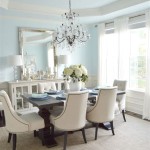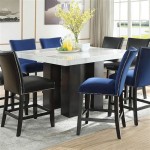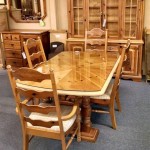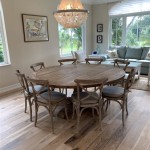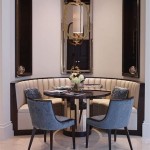Dining Room Tables for Large Families: A Comprehensive Guide
Finding the right dining room table for a large family presents a unique set of challenges. It necessitates balancing space constraints, aesthetic preferences, and, most importantly, accommodating a significant number of people comfortably. This article delves into the considerations that should inform the selection of a dining room table suitable for a large family, examining various shapes, materials, styles, and essential features.
Assessing Space and Capacity
The first step in selecting a dining room table for a large family involves a thorough assessment of the available dining space. It is crucial to measure the room accurately and account for other furniture, such as sideboards, cabinets, or walkways. Adequate space should be left around the table to allow for comfortable movement and seating without obstructing pathways. Consider the minimum amount of space needed for each person to sit comfortably, generally estimated to be around 24 inches in width and 12 inches in depth. Beyond the chairs, an additional 36 inches of clearance around the table is recommended to allow people to easily get in and out of their seats.
Understanding the typical number of individuals who will regularly use the table is paramount. While occasional guests might require additional seating arrangements, the table should primarily cater to the everyday needs of the immediate family. Overestimating capacity can lead to unnecessary space consumption, while underestimating capacity necessitates supplemental seating options that may disrupt the overall aesthetic.
Extension tables offer a practical solution for families who regularly host larger gatherings. These tables can be expanded when needed and reduced in size for everyday use, providing flexibility without sacrificing space. Extension mechanisms vary, ranging from leaves that are stored separately to built-in butterfly leaves that fold out from under the tabletop. Evaluate the ease of use and storage of the extension mechanism to ensure it aligns with the family's lifestyle.
Exploring Table Shapes and Sizes
The choice of table shape significantly impacts seating capacity and the overall flow of the dining room. Rectangular tables are a common selection, offering ample surface area and accommodating a large number of people. They are well-suited for longer, narrower dining rooms. Square tables, while aesthetically pleasing, typically accommodate fewer people than rectangular tables and are best suited for smaller families or square-shaped dining rooms.
Round tables promote conversation and create a more intimate dining experience. However, they can be less efficient in terms of maximizing seating capacity, particularly for larger groups. Oval tables offer a compromise between rectangular and round shapes, providing a greater seating capacity than round tables while maintaining a softer, more inviting aesthetic than rectangular tables. The ideal table size is directly correlated to the room size and the number of people the table needs to accommodate. It is recommended to use online calculators or consult with interior design professionals to determine the optimal dimensions.
Beyond traditional shapes, consider less conventional options such as boat-shaped tables or racetrack-shaped tables. These shapes offer a unique aesthetic and can often accommodate more people than a similarly sized rectangular table due to their curved edges.
Material Selection and Durability Considerations
The material of the dining room table is a critical factor in determining its durability, maintenance requirements, and overall aesthetic. Wood is a popular choice due to its warmth, natural beauty, and versatility. Solid wood tables are exceptionally durable and can withstand years of use, but they require proper care and maintenance to prevent scratches, stains, and warping. Hardwoods such as oak, maple, and walnut are particularly resistant to wear and tear. Veneer tables offer a more affordable alternative to solid wood, but they are less durable and more susceptible to damage.
Glass-top tables offer a contemporary aesthetic and are easy to clean. However, they can be prone to scratches and fingerprints and may not be suitable for families with young children. Tempered glass is a safer option, as it is more resistant to breakage and shatters into small, relatively harmless pieces. Metal tables are durable and require minimal maintenance. They offer a sleek, modern look and are often used in industrial-style dining rooms. However, metal tables can be cold to the touch and may not be as aesthetically versatile as wood tables.
Laminate tables are a budget-friendly option that is resistant to scratches and stains. They come in a wide range of colors and patterns, making it easy to find a style that complements the dining room décor. However, laminate tables are less durable than solid wood or metal tables and may not hold up well to heavy use over time. When selecting a material, consider the family's lifestyle and the level of maintenance required. Families with young children may prefer materials that are easy to clean and resistant to stains and scratches.
Style and Design Cohesion
The style of the dining room table should complement the overall aesthetic of the dining room. Consider the existing furniture, wall colors, and flooring when selecting a table. A traditional dining room might benefit from a classic wooden table with ornate details, while a modern dining room might be better suited to a sleek metal or glass table with clean lines. A farmhouse-style dining room could incorporate a rustic wooden table with a distressed finish.
The table's base or legs are an important design element that can significantly impact the overall look and feel. Pedestal bases offer more legroom than tables with four legs, making them a comfortable option for large families. Trestle tables provide a rustic, traditional aesthetic, while metal legs offer a modern, industrial touch. Consider the height of the table in relation to the chairs. The ideal distance between the tabletop and the chair seat is around 12 inches.
The color of the dining room table should also complement the dining room décor. Dark wood tables create a formal, elegant atmosphere, while light wood tables create a more casual, inviting atmosphere. Glass-top tables allow the flooring and surrounding furniture to be the focal point. Consider incorporating decorative elements, such as a centerpiece, placemats, or runners, to enhance the table's aesthetic appeal.
Finishes and Maintenance
The finish applied to a dining room table not only impacts its appearance but also its durability and maintenance requirements. A polyurethane finish provides a durable, water-resistant surface that is easy to clean. Oil finishes penetrate the wood, enhancing its natural beauty and providing a soft, matte finish. However, oil finishes require regular maintenance to prevent water rings and stains.
Varnishes offer a high-gloss finish that is resistant to scratches and stains. However, they can be more difficult to repair than other finishes. Lacquer finishes provide a smooth, durable surface that is resistant to yellowing. However, they are sensitive to heat and solvents. When selecting a finish, consider the family's lifestyle and the level of maintenance required. Families with young children may prefer a finish that is easy to clean and resistant to stains and scratches.
Regular cleaning is essential to maintaining the appearance of a dining room table. Wipe the table down after each meal with a damp cloth to remove food particles and spills. Use a mild soap and water solution for more stubborn stains. Avoid using harsh chemicals or abrasive cleaners, as they can damage the finish. Apply furniture polish or oil periodically to protect the wood and enhance its natural beauty.
Evaluating Seating Options
Selecting the right chairs is as important as selecting the right dining room table. The chairs should be comfortable, durable, and complement the table's style. Consider the height of the chairs in relation to the table. The ideal distance between the tabletop and the chair seat is around 12 inches.
Upholstered chairs provide added comfort, but they are more susceptible to stains and spills. Wooden chairs are durable and easy to clean, but they may not be as comfortable as upholstered chairs. Metal chairs offer a modern, industrial look and are easy to maintain. Consider incorporating a mix of seating options, such as chairs and benches, to create a more diverse and inviting dining area. Benches are a space-saving option that can accommodate multiple people. However, they may not be as comfortable as individual chairs.
Ensure that the chairs can be easily tucked under the table when not in use, saving space and preventing obstructions. Consider the storage options for extra chairs. Folding chairs can be easily stored away when not needed, providing flexibility for larger gatherings.
Considering Budget and Long-Term Value
The budget is a significant factor in the selection of a dining room table. Set a realistic budget before beginning the search, and stick to it. Dining room tables range in price from affordable laminate tables to high-end solid wood tables. Consider the long-term value of the table. A durable, well-made table can last for many years, making it a worthwhile investment. Compare prices from different retailers to ensure you are getting the best deal.
Consider purchasing a used dining room table. Used tables can be a great way to save money, and they often have a unique character. Inspect the table carefully for damage before purchasing it. Factor in the cost of delivery and assembly. Some retailers offer free delivery and assembly, while others charge extra. Read online reviews to get an idea of the table's quality and durability.
Consider the resale value of the table. A well-maintained solid wood table can retain its value over time, making it a good investment. Be prepared to spend more for a table that will meet the family's needs and last for many years to come. A dining room table is an investment that will be used every day, so it is worth spending the time and effort to find the perfect one.

Chvans 71 Inch Large Rectangular Dining Table For 6 8 People With Waterproof Marble Color Wood Tabletop And Adjustable Legs

Black Family Size Large Formal Dining Tables Chairs Sets Comfyco

118 1 Large Kitchen Dining Table For 12 People Rectangular With A Simple And Family Banquet Dinner Or Celebration

71 Inch Large Rectangular Dining Table For 6 8 People With Marble Color Wood Waterproof Tabletop And Adjustable Leg 6ft Luxurious

Big Dining Table Family Walnut Maker Marketplace

Chester Dining Table

Dining Room Design Ideas For Big And United Families

Byblight Moronia Light Brown Wood 70 9 In Pedestal Dining Table Seats 8 Rectangular Farmhouse Kitchen For Big Family Bb Jw0903lc

71 Large Luxurious Rectangular White Dining Table For 6 8 10 People With Marble Tabletop Metal Adjustable Leg Modern 6ft Family Dinner T

Large Dining Table Big Long Family Style Maker Marketplace


